供应链管理(英文)
- 格式:ppt
- 大小:1003.00 KB
- 文档页数:27
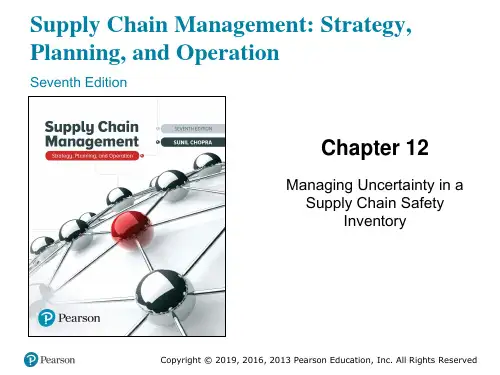

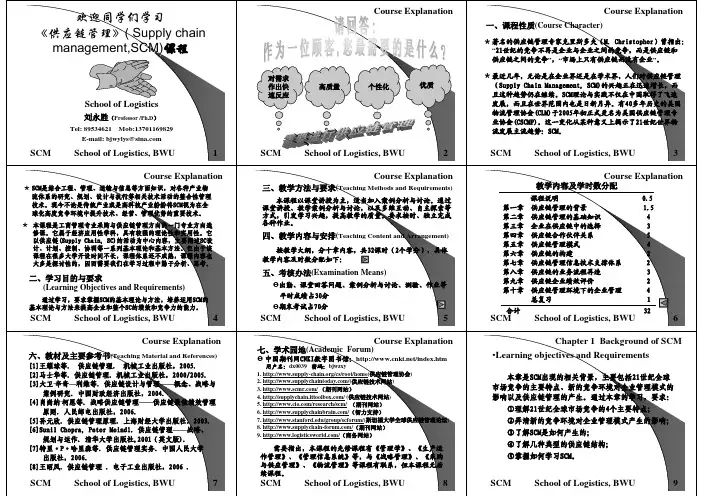


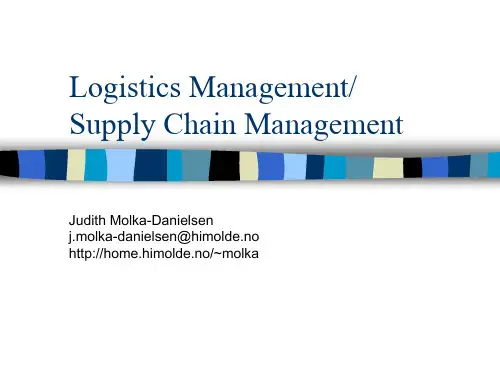
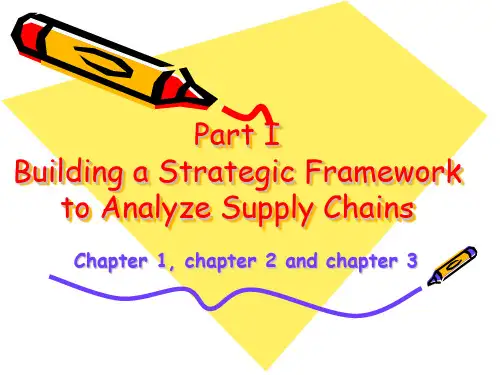
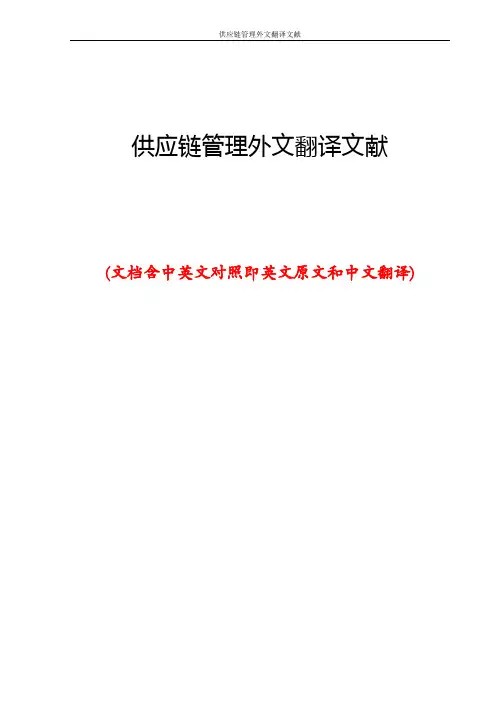
供应链管理外文翻译文献供应链管理外文翻译文献(文档含中英文对照即英文原文和中文翻译)Supply Chain ManagementThe so-called supply chain, in fact, from suppliers, manufacturers, warehouses, istribution centers and channels, and so constitute a logistics network. The same enterprise may constitute the different components of this network node, but the situation is different from a corporate network in different nodes. For example, in a supply chain, companies may not only in the same manufacturers, storage nodes, and in distribution centers, such as possession node location. In the more detailed division of labor, the higher the rofessional requirements of the supply chain, different nodes are basically composed by different enterprises. In the supply chain flows between the member units of raw materials, finished products, such as inventory and production constitutes the supply chain of goods flow.That is, to meet a certain level of customer service under the conditions, in order to make the whole supply chain to minimize costs and the suppliers, manufacturers, warehouses, distribution centers and channels, and so effectively organized together to carry out Product manufacturing, transport, distribution and sales management.From the above definition, we can be interpreted to include supply chain anagement of rich content.First of all, supply chain management products to meet customer demand in the process of the cost implications of various members of the unit are taken intoaccount, including from raw material suppliers, manufacturers to the warehouse distribution center to another channel. However, in practice in the supply chain analysis, it is necessary to consider the supplier's suppliers and customers of the customers, because their supply chain performance is also influential.Second, supply chain management is aimed at the pursuit of the whole supply chain's overall efficiency and cost effectiveness of the system as a whole, always trying to make the total system cost to a minimum. Therefore, the focus of supply chain management is not simply a supply chain so that members of the transportation costs to minimize or reduce inventory, but through the use of systems approach to coordinate the supply chain members so that the entire supply chain total cost of the minimum so that the whole supply chain System in the most fluent in the operation.Third, supply chain management is on the suppliers, manufacturers, warehouses, distribution centers and organically integrate the channel into one to start this problem, so many businesses, including its level of activities, including the strategic level, tactical and operational level Level, and so on.Although the actual logistics management, only through the organic supply chain integration, enterprises can significantly reduce costs and improve service levels, but in practice the supply chain integration is very difficult, it is because: First of all, in the supply chain There are different members of different and conflicting objectives. For example, providers generally want manufacturers to purchase large quantities of stable, and flexible delivery time can change; desire to the contrary with suppliers, although most manufacturers are willing toimplement long-term production operations, but they must take into account the needs of its customers and to make changes Positive response, which requires manufacturers choice and flexibility in procurement strategy. Therefore, suppliers and manufacturers to the goal of flexibility in the pursuit of the objectives inevitably exist between the contradictions.Secondly, the supply chain is a dynamic system, with time and constantly changing. In fact, customers not only demand and supply capacity to change over time, supply chain and the relationship between the members will change over time. For example, the increased purchasing power with customers, suppliers and manufacturers are facing greater pressure to produce more and more personalized varieties of high-quality products, then ultimately the production of customized products.Research shows that effective supply chain management can always make the supply chain of enterprises will be able to maintain stability and a lasting competitive advantage, thus increasing the overall supply chain competitiveness. Statistics show that, supply chain management will enable the effective implementation of enterprise total cost of about 20 per cent decline in the supply chain node on the enterprise-time delivery rate increased by 15 percent or more, orders to shorten the production cycle time 20 percent to 30 percent, supply chain Node on the enterprise value-added productivity increased by 15 percent or more. More and more enterprises have already recognized that the implementation of supply chain management of the great benefits, such as HP,IBM, DELL, such as supply chain management in the practice of the remarkable achievements made is proof.Supply chain management: it from a strategic level and grasp the overall perspective of the end-user demand, through effective cooperation between enterprises, access from the cost, time, efficiency, flexibility, and so the best results. From raw materials to end-users of all activities, the whole chain of process management.SCM (supply chain management) is to enable enterprises to better procurement of manufactured products and services required for raw materials, production of goods and services and their delivery to clients, the combination of art and science. Supply chain management, including the five basic elements.Plan: This is a strategic part of SCM. You need a strategy to manage all the resources to meet our customers for your products. Good plan is to build a series of methods to monitor the supply chain to enable it to effective, low-cost delivery of high quality for customers and high-value products or services.Procurement: you can choose the products and services to provide goods and services providers, and suppliers to establish a pricing, delivery and payment processes and create methods to monitor and improve the management, and the suppliers to provide goods and services Combined with management processes, including the delivery and verification of documentation, transfer of goods to your approval of the manufacturing sector and payments to suppliers and so on.Manufacturing: arrangements for the production, testing, packaged and ready for delivery, supply chain measurement is the largest part of the contents, including the level of quality, product yield and productivity of workers, such as the measurement.Delivery: a lot of "insider" as "logistics", is to adjust the user's orders receipts, the establishment of the storage network, sending and delivery service delivery personnel to the hands of customers, the establishment of commodity pricing system, receiving payments.Return: This is the supply chain problems in the handling part. Networking customers receive the refund of surplus and defective products, and customer applications to provide support for the problem.Source70 in the late 20th century, Keith Oliver adoption and Skf, Heineken, Hoechst, Cadbury-Schweppes, Philips, and other contact with customers in the process of gradually formed its own point of view. And in 1982, "Financial Times" magazine in an article on the supply chain management (SCM) of the significance, Keith Oliver was that the word will soon disappear, but "SCM" not only not disappeared, and quickly entered the public domain , The concept of the managers of procurement, logistics, operations, sales and marketing activities sense a great deal.EvolutionSupply chain has never been a universally accepted definition, supply chain management in the development process, many experts and scholars have putforth a lot of definition, reflecting the different historical backgrounds, in different stages of development of the product can be broadly defined by these For the three stages:1, the early view was that supply chain is manufacturing enterprises in an internal process2, but the supply chain concept of the attention of the links with other firms 3, the last of the supply chain concept of pay more attention around the core of the network links between enterprises, such as core business with suppliers, vendors and suppliers, and even before all the relations, and a user, after all the users and to the relationship.ApplySupply chain management involves four main areas: supply, production planning, logistics, demand. Functional areas including product engineering, product assurance, procurement, production control, inventory control, warehouse management, distribution management. Ancillary areas including customer service, manufacturing, design engineering, accounting, human resources, marketing.Supply Chain Management implementation steps: 1, analysis of market competition environment, identify market opportunities, 2, analysis of customer value, 3, identified competitive strategy, 4, the analysis of the core competitiveness of enterprises, 5, assessment, selection of partners For the supply chain partners of choice, can follow the following principles:1, partners must have available the core of their competitiveness.2, enterprises have the same values and strategic thinking3, partners must Fewer but Better.CaseAs China's largest IT distributor, Digital China in China's supply chain management fields in the first place. In the IT distribution model generally questioned the circumstances, still maintained a good momentum of development, and CISCO, SUN, AMD, NEC, IBM, and other famous international brands to maintain good relations of cooperation. e-Bridge trading system in September 2000 opening, as at the end of March 2003, and 6.4 billion yuan in transaction volume. In fact, this is the Digital China from the traditional distribution supply chain services to best reflect the changes. In the "distribution of services is a" concept, Digital China through the implementation of change channels, expansion of product and service operations, increasing its supply chain in the value of scale and specialized operations, to meet customer demand on the lower reaches of the In the course of the supply chain system can provide more value-added services, with more and more "IT services" color.供应链管理所谓供应链,其实就是由供应商、制造商、仓库、配送中心和渠道商等构成的物流网络。
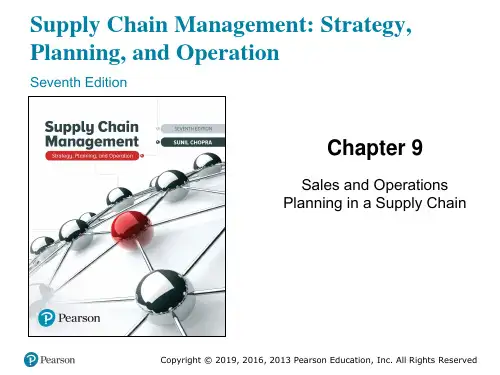
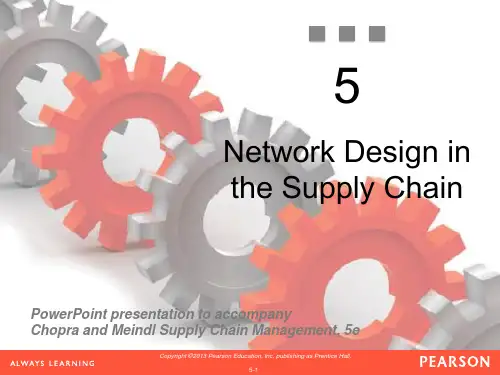

供应链管理整体介绍
供应链管理是指对整个供应链系统进行计划、协调、操作、控制和优化的各种活动和过程,其目标是要将顾客所需的正确的产品(Right Product)能够在正确的时间(Right Time)、按照正确的数量(Right Quantity)、正确的质量(Right Quality)和正确的状态(Right Status)送到正确的地点(Right Place),并使总成本达到最佳化。
供应链管理的主要领域包括采购、生产、物流、销售等环节,通过协调各个环节之间的关系,提高供应链的效率和效益。
供应链管理涉及到的主要内容包括供应链策略制定、供应链伙伴关系管理、供应链物流管理、供应链信息管理、供应链风险管理等。
在当今全球化和竞争激烈的商业环境中,有效的供应链管理对于企业的成功至关重要。
它可以帮助企业降低成本、提高效率、提高客户满意度、增强竞争力,并促进企业的可持续发展。
总之,供应链管理是一个综合性的管理领域,它涵盖了从原材料采购到产品交付的整个过程,通过优化供应链的各个环节,实现企业的战略目标。
常用管理英文缩写已有 529 次阅读2010-12-30 10:49|5S : 5S管理ABC : 作业制成本制度(Activity-Based Costing)ABB : 实施作业制预算制度(Activity-Based Budgeting)ABM : 作业制成本管理(Activity-Base Management)APS : 先进规画与排程系统(Advanced Planning and Scheduling) ASP : 应用程序服务供货商(Application Service Provider)ATP : 可承诺量(Available To Promise)AVL : 认可的供货商清单(Approved Vendor List)BOM : 物料清单(Bill Of Material)BPI : 企业流程改进(Business Process Improvement)BPR : 企业流程再造(Business Process Reengineering)BSC : 平衡记分卡(Balanced ScoreCard)BTF : 计划生产(Build To Forecast)BTO : 订单生产(Build To Order)CIM : 计算机集成制造(Computer Integrated Manufacturing)CPM : 要径法(Critical Path Method)CPM : 每一百万个使用者会有几次抱怨(Complaint per Million) CRM : 客户关系管理(Customer Relationship Management) CRP : 产能需求规划(Capacity Requirements Planning)CTO : 客制化生产(Configuration To Order)DBR : 限制驱导式排程法(Drum-Buffer-Rope)DMT : 成熟度验证(Design Maturing Testing)DVT : 设计验证(Design Verification Testing)DRP : 运销资源计划(Distribution Resource Planning)DSS : 决策支持系统(Decision Support System)EC : 设计变更/工程变更(Engineer Change)EC : 电子商务(Electronic Commerce)ECRN : 原件规格更改通知(Engineer Change Request Notice) EDI : 电子数据交换(Electronic Data Interchange)EI* : 主管决策系统(**ecutive Information System)EMC : 电磁相容(Electric Magnetic Capability)EOQ : 基本经济订购量(Economic Order Quantity)ERP : 企业资源规划(Enterprise Resource Planning)FAE : 应用工程师(Field Application Engineer)FCST : 预估(Forecast)FMS : 弹性制造系统(Flexible Manufacture System)FQC : 成品质量管理(Finish or Final Quality Control)IPQC: 制程质量管理(In-Process Quality Control)IQC : 进料质量管理(Incoming Quality Control)ISO : 国际标准组织(International Organization for Standardization) ISAR: 首批样品认可(Initial Sample Approval Request)JIT : 实时管理(Just In Time)KM :知识管理(Knowledge Management)L4L : 逐批订购法(Lot-for-Lot)LP : 精益生产(Lean Production)LTC : 最小总成本法(Least Total Cost)LUC : 最小单位成本(Least Unit Cost)MBO : 管理层收购(Management Buy-out)MES : 制造执行系统(Manufacturing Execution System)MO : 制令(Manufacture Order)MPS : 主生产排程(Master Production Schedule)MRO : 请修(购)单(Maintenance Repair Operation)MRP : 物料需求规划(Material Requirement Planning)MRPII : 制造资源计划(Manufacturing Resource Planning)NFCF : 更改预估量的通知Notice for Changing ForecastOEM : 委托代工(Original Equipment Manufacture)ODM : 委托设计与制造(Original Design & Manufacture)OLAP : 在线分析处理(On-Line Analytical Processing)OLTP : 在线交易处理(On-Line Transaction Processing)OPT : 最佳生产技术(Optimized Production Technology)OQC : 出货质量管理(Out-going Quality Control)PDCA : 戴明环——PDCA管理循环(Plan-Do-Check-Action) PDM : 产品数据管理系统(Product Data Management)PERT : 计划评核术(Program Evaluation and Review Technique) PO : 订单(Purchase Order)POH : 预估在手量(Product on Hand)PR : 采购申请Purchase RequestQA : 品质保证(Quality Assurance)QC : 质量管理(Quality Control)QCC : 品管圈(Quality Control Circle)QE : 品质工程(Quality Engineering)RCCP : 粗略产能规划(Rough Cut Capacity Planning)RMA : 退货验收Returned Material ApprovalROP : 再订购点(Re-Order Point)SCM : 供应链管理(Supply Chain Management)SFC : 现场控制(Shop Floor Control)SIS : 策略信息系统(Strategic Information System)SO : 订单(Sales Order)SOR : 特殊订单需求(Special Order Request)SPC : 统计制程管制(Statistic Process Control)TOC : 限制理论(Theory of Constraints)TPM : 全面生产管理Total Production ManagementTQC : 全面质量管理(Total Quality Control)TQM : 全面品质管理(Total Quality Management) WIP : 在制品(Work In Process)。
制定仓库管理方案英文缩写背景随着企业业务规模的扩大,仓库管理变得越来越重要。
在实际操作中,仓库管理方案标准化,规范化,科学化的指导意义越来越显著。
制定一份符合企业实际需要的仓库管理方案对于提升企业内部物流运作效率、降低物流成本、提高物流管理水平具有十分重要的积极影响。
为了便于仓库管理方案在业务活动中的交流,需要对仓库管理方案进行英文缩写。
目标本文档旨在制定符合企业实际需要的仓库管理方案英文缩写,为企业内部物流运作效率的提升、物流成本的降低,以及物流管理水平的提高提供依据和参考。
方案为了制定符合企业实际需要的仓库管理方案英文缩写,我们先来了解一下相关的词汇:1.仓库管理Warehouse Management, 缩写为 WMS2.物料管理Material Management, 缩写为 MM3.库存管理Inventory Management, 缩写为 IM4.运输管理Transportation Management, 缩写为 TM5.客户关系管理Customer Relationship Management, 缩写为 CRM6.供应链管理Supply Chain Management, 缩写为 SCM7.信息技术支持Information Technology Support, 缩写为 ITS8.平台建设Platform Construction, 缩写为 PC9.数据分析Data Analysis, 缩写为 DA10.海关报关Customs Declaration, 缩写为 CD11.安全管理Security Management, 缩写为 SM12.装卸管理Loading and Unloading Management, 缩写为 LUM13.进销存管理Purchase-Sale-Stock Management, 缩写为 PSSM基于以上词汇,我们可以制定如下供企业内部使用的英文缩写方案:•仓库管理:WMS•物料管理:MM•库存管理:IM•运输管理:TM•客户关系管理:CRM•供应链管理:SCM•信息技术支持:ITS•平台建设:PC•数据分析:DA•海关报关:CD•安全管理:SM•装卸管理:LUM•进销存管理:PSSM结论本文档采用简明、明了的方式,制定了一份符合企业实际需要的仓库管理方案英文缩写方案,以便于企业内部物流运作效率的提升、物流成本的降低,以及物流管理水平的提高。
供应链专业术语缩写及含义供应链管理(Supply Chain Management,缩写为SCM)是指对包括原材料供应商、制造商、分销商和零售商在内的全部供应链进行综合管理和协调,以最大限度地提高供应链的效率和效益。
对于供应链管理专业术语的缩写来说,众多术语会以英文首字母的缩写形式来呈现。
本文将为大家介绍一些常见的供应链管理专业术语的缩写及其含义,从而帮助读者更好地了解和掌握相关知识。
1.供应链管理(Supply Chain Management,SCM)供应链管理是一个涵盖范围非常广泛的领域,其内容包括供应链规划、采购管理、生产计划、库存管理、物流管理、销售预测和分销管理等方面。
SCM的目标是通过优化供应链各个环节的协调和一体化,实现资源的高效利用,从而提高整个供应链的绩效和竞争力。
2.采购管理(Procurement Management,PM)采购管理是指在供应商选择、采购合同签订、供应商绩效评估和风险管理等方面对采购活动进行全面管理和控制的过程。
通过采购管理,企业可以确保自身所需的原材料和零部件的质量、交货期和成本等方面得到有效控制。
3.生产计划(Production Planning,PP)生产计划是指确定生产计划量、生产周期、生产计划资源和排产计划的过程。
通过生产计划,企业可以合理安排生产资源和生产计划,确保生产活动的高效进行,提高生产效率和降低生产成本。
4.库存管理(Inventory Management,IM)库存管理是指对企业库存水平的控制和优化的过程。
通过库存管理,企业可以合理安排货物的接收、存储、发放和盘点等活动,以最大限度地降低库存成本和提高库存周转率。
5.物流管理(Logistics Management,LM)物流管理是指对物流活动的计划、实施和控制的过程。
通过物流管理,企业可以实现物流成本的节约、物流服务的提升和物流效率的提高,从而提升企业的竞争力和盈利能力。
6.供应链规划(Supply Chain Planning,SCP)供应链规划是指对供应链各个环节的计划和协调的过程。
物流术语?基础术语物品 goods物流 logistics物流活动 logistics activity物流管理 logistics management供应链 supply chain供应链管理 supply chain management服务 service物流服务 logistics service一体化物流服务 integrated logistics service 物流系统logistics system第三方物流 the third party logistics物流设施 logistics establishment物流中心 logistics center配送中心 distribution center分拨中心 distribution center物流园区 logistics park物流企业 logistics enterprise物流作业 logistics operation物流模数 logistics modulus物流技术 logistics technology物流成本 logistics cost物流网络 logistics network物流信息 logistics information物流单证 logistics documents物流联盟 logistics alliance物流作业流程 logistics operation process 企业物流 internal logistics供应物流supply logistics生产物流production logistics销售物流 distribution logistics社会物流 external logistics军事物流 military logistics项目物流 project logistics国际物流 International logistics虚拟物流 virtual logistics精益物流 lean logistics反向物流reverse logistics回收物流 return logistics废弃物物流 waste material logistics货物运输量 freight volume货物周转量 turnover volume of freight transport 军事物资 military material筹措 raise军事供应链 military supply chain军地供应链管理 military supply chain management军事物流一体化 integration of military logistics and civil logistics物流场 logistics field战备物资储备 military repertory of combat readiness全资产可见性 total asset visibility配送式保障 distribution-mode support作业服务术语托运 consignment承运 carriage承运人 carrier运输 transportation道路运输 road transport水路运输 waterway transport铁路运输 railway transport航空运输 air transport管道运输 pipeline transport门到门服务 door to door service直达运输 through transportation中转运输 transfer transportation甩挂运输 drop and pull transport整车运输 transportation of truck-load零担运输 sporadic freight transportation 联合运输 combined transport联合费率 joint rate联合成本 joint cost仓储 warehousing储存 storing库存 inventory库存成本 inventory cost保管 storage仓单? storage invoice仓单质押融资 Warehouse receipt hypothecating/ Depot bill pledge 库存商品融资Inventory Financing仓储费用? warehousing fee订单满足率 fill rate货垛 goods stack堆码 stacking?配送 distribution拣选 order picking分类 sorting集货 goods consolidation共同配送 joint? distribution装卸 loading and unloading搬运 handling carrying包装? package/packaging销售包装? sales package运输包装 transport? package流通加工 distribution processing检验inspection增值物流服务 value-added logistics service定制物流customized logistics物流客户服务 logistics customer service物流运营服务 logistics operation service物流服务质量 logistics service quality?物品储备 goods reserves缺货率 stock-out rate货损率 cargo damages rate商品完好率 rate of the goods in good condition基本运价freight unit price理货 tally组配 assembly订货周期 order cycle time库存周期 inventory cycle time技术与设施设备术语标准箱 twenty-feet equivalent unit (TEU) 集装运输? containerized transport托盘运输 pallet transport货物编码 goods coding四号定位 four number location零库存技术 zero-inventory technology单元装卸? unit loading & unloading气力输送法 pneumatic conveying system生产输送系统 production line system分拣输送系统 sorting & picking system自动补货 automatic replenishment自动存储取货系统 automated storage & retrieval system (AS/RS) 集装化? containerization?散装化? in bulk托盘包装 palletizing直接换装 cross docking物流系统仿真 logistics system simulation冷链cold chain自营仓库 private warehouse公共仓库 public warehouse自动仓库 automated storage & retrieval system立体仓库 stereoscopic warehouse交割仓库 transaction warehouse交通枢纽 traffic hinge集装箱货运站container freight station (CFS)?集装箱码头 container terminal控湿储存区 humidity controlled space?冷藏区 chill space冷冻区 freeze space收货区 receiving space区域配送中心 regional distribution center (RDC) 公路集装箱中转站 inland container depot?铁路集装箱场 railway container yard专用线 special railway line基本港口 base port周转箱 container叉车 fork lift truck?叉车属具 attachments of fork lift trucks托盘 pallet?称量装置 load weighing devices工业用门 industrial door货架 goods shelf重力货架系统 live pallet rack system移动货架系统 mobile rack system驶入货架系统 drive-in rack system集装袋 flexible freight bags集装箱 container特种货物集装箱 specific cargo container 集装单元器具 palletized unit implants 全集装箱船 full container ship码垛机器人 robot palletizer起重机械 hoisting machinery牵引车 tow tractor升降台 lift table (LT)输送机 conveyors箱式车 box car自动导引车 automatic guided vehicle? (AGV)自动化元器件 element of automation手动液压升降平台车scissor lift table零件盒 working? accessories条码打印机 bar code printer站台登车桥 dock levelers信息术语条码 bar code商品标识代码 identification code for commodity 产品电子编码 Electronic Product Code (EPC) EPC序列号 serial number对象名称解析服务 object name service (ONS)对象分类 object class位置码 location number (LN)?贸易项目 trade item物流单元 logistics unit全球贸易项目标识代码 global trade item number 应用标识符 application? identifier (AI)物流信息编码? logistics information code自动数据采集 automatic data capture (ADC)自动识别技术auto identification条码标签 bar code tag条码识读器 bar code reader条码检测仪 bar code verifier条码系统 bar code system条码自动识别技术 bar code auto ID射频标签 RFID tag射频识读器 RFID reader射频识别 radio frequency identification? (RFID)射频识别系统 RFID systemEPC系统 EPC system数据元 metadata报文 message实体标记语言 Physical Markup Language (PML)电子数据交换 electronic data interchange (EDI)电子通关 electronic clearance电子认证? electronic authentication电子报表? e-report电子采购? e-procurement电子合同? e-contract电子商务? e-commerce (EC)电子支付? e-payment地理信息系统 geographical information system (GIS)全球定位系统global positioning system (GPS)智能交通系统 intelligent transportation system (ITS) 货物跟踪系统 goods-tracked system仓库管理系统 warehouse management system (WMS)销售时点系统point of sale (POS)电子订货系统 electronic order system (EOS)计算机辅助订货系统 computer assisted ordering (CAO) 拉式订货系统 pull order system永续存货系统 perpetual inventory system虚拟仓库 virtual warehouse物流信息系统 logistics information system (LIS)物流信息技术 logistics information technology物流信息分类 logistics information sorting分布式的网络软件 savant管理术语仓库布局? warehouse layoutABC分类管理 ABC classification安全库存 safety stock经常库存 cycle stock库存管理 inventory management库存控制 inventory control供应商管理库存 vendor managed inventory (VMI)定量订货制 fixed-quantity system (FQS)定期订货制 fixed-interval system (FIS)经济订货批量 economic order quantity (EOQ)连续补货计划 continuous replenishment program (CRP) 联合库存管理 joint managed inventory (JMI)前置期 lead time?物流成本管理 logistics cost control物流绩效管理 logistics performance management物流战略 logistics strategy物流战略管理 logistics strategy management物流质量管理 logistics quality management物流资源计划? logistics resource planning (LRP)供应链联盟? supply chain alliance供应商关系管理 supplier relationships management (SRM) 准时制 just in time (JIT)?准时制物流 just-in-time logistics?有效客户反应 efficient customer response (ECR)快速反应? quick response (QR)?物料需求计划 material requirements planning (MRP)制造资源计划manufacturing resource planning (MRPⅡ)配送需求计划 distribution requirements planning (DRP) 配送资源计划? distribution resource planning (DRPⅡ)企业资源计划? enterprise resource planning (ERP)协同计划、预测与补货collaborative planning,forecasting and replenishment (CPFR)服务成本定价法 cost-of-service pricing服务价值定价法 value-of-service pricing业务外包 outsourcing流程分析法 process analysis延迟策略 postponement strategy业务流程重组? business process reengineering(BPR)物流流程重组? logistics process reengineering有形损耗 tangible loss无形损耗 intangible loss?总成本分析 total cost analysis物流作业成本法 logistics activity-based costing效益悖反 trade off国际物流术语多式联运 multimodal transport国际多式联运 international multimodal transport国际航空货物运输 international airline transport国际铁路联运 international through railway transport 班轮运输liner transport?租船运输 shipping by chartering大陆桥运输 land bridge transport保税运输 bonded transport转关运输Tran-customs transportation报关 customs declaration报关行 customs broker不可抗力 accident beyond control保税货物 bonded goods海关监管货物cargo under custom’s supervision拼箱货 less than container load (LCL)整箱货 full container load (FCL)通运货物 through goods转运货物 transit cargo自备箱shipper’s own container到货价格 delivered price出厂价 factory price成本加运费cost and freight (CFR)出口退税 drawback过境税 transit duty海关估价 customs ratable price等级标签 grade labeling等级费率 class rate船务代理 shipping agency国际货运代理 international freight forwarding agent无船承运业务 non vessel operating common carrier business 无船承运人 NVOCC non vessel operating、common carrier索赔 claim for damages理赔 settlement of claim国际货物运输保险 international transportation cargo insurance 原产地证明 certificate of origin进出口商品检验 commodity inspection清关 clearance滞报金 fee for delayed declaration装运港船上交货 free on board (FOB)进料加工 processing with imported materials来料加工 processing with supplied materials保税仓库 boned warehouse保税工厂 bonded factory保税区 bonded area保税物流中心 bonded logistics center保税物流中心A型 bonded logistics center of A type保税物流中心B型 bonded logistics center of B type 融通仓 financing warehouse出口监管仓库 export supervised warehouse出口加工区 export processing zone定牌包装 packing of nominated brand中性包装? neutral packing提单(海运提单) bill of lading。